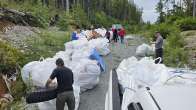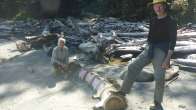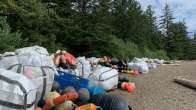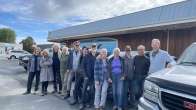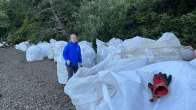Clear the Coast
Through initiatives like Clear the Coast, we work to protect sensitive foreshore, recovering habitat polluted by ocean plastics.
Plastics have significant impacts on climate change at every stage of their lifecycle. The impacts are undercounted, and therefore plastics are using more of the carbon budget than currently assumed. Read about plastics’ climate impacts and how filling in the scientific knowledge gaps are paramount if the challenges related to plastics, climate change, and related crises are to be addressed in the "Including the Undercounted Climate Impacts of Plastics in the UN Climate Regime" Brief from COP-30.
Clear the Coast 2024
Our June expedition filled up before we got the chance to advertise it! That's a clear indication we've got an eager crew of volunteers ready to work.
The June expedition will be a short one as usual and we're going to Cox Island, the nearest in the Scott Islands group. The trip is made possible by a grant from Blue Friday--a fundraising initiative that is the brain child of another great volunteer, Jeff Duke of LL Supply. Jeff has brought together a group of like-minded entrepreneurs who stand Black Friday on its head by donating a portion of that day's sales to protecting the ocean. We are thrilled to have been chosen as the Blue Friday project again this year!
If you were hoping to participate this year, please check this space later in the spring--we'll post our plans as funding becomes available. We've applied for funding to clean the entire North Coast Trail, Cape Scott Trail, the west coast beaches of Cape Scott Provincial Park AND the Scott Islands. Funding decisions are expected in June.
Why do we do what we do?
Marine debris can be as harmful to ocean ecosystems as destructive fishing practices. Tonnes of plastic waste are circulating on ocean currents and breaking down into smaller and smaller particles, often ending up on or inside seabirds, marine mammals and fish. Lost fishing gear can entangle and kill many marine species. Closer to shore, debris accumulates on beaches including near-shore waters like estuaries that have a high conservation value. Derelict and abandoned vessels are a threat to pollute harbours and other coastal areas.
Derelict vessels
 Old and derelict vessels are another form of debris and a threat to the marine environment. Their growing presence and disposal is becoming a growing concern for marina operators on B.C.'s coast. These vessels become point sources of pollution, leaking hydrocarbons and other harmful toxins into the ocean. If anchored or abandoned on beaches, they may become hazards to navigation.
Old and derelict vessels are another form of debris and a threat to the marine environment. Their growing presence and disposal is becoming a growing concern for marina operators on B.C.'s coast. These vessels become point sources of pollution, leaking hydrocarbons and other harmful toxins into the ocean. If anchored or abandoned on beaches, they may become hazards to navigation.
Living Oceans has studied how derelict vessels impact marine ecosystems and how lessons learned and best practices from vessel removal efforts in other places can be applied on northern Vancouver Island. This research will provide local harbour managers, marinas and other businesses with a starting point to develop local solutions to the hazards and pollution problems posed by abandoned and derelict vessels.
Ghost fishing gear
 Even after it’s lost, fishing gear continues to fish by trapping or entangling sea life. Local organizations and volunteers want to find and remove lost crab traps from recreational fishing areas in and near estuaries. We are collecting the information reported during these cleanup efforts into the Clear the Coast map that shows how and where the ghost gear interacts with important habitat like kelp beds and eelgrass meadows.
Even after it’s lost, fishing gear continues to fish by trapping or entangling sea life. Local organizations and volunteers want to find and remove lost crab traps from recreational fishing areas in and near estuaries. We are collecting the information reported during these cleanup efforts into the Clear the Coast map that shows how and where the ghost gear interacts with important habitat like kelp beds and eelgrass meadows.
Are You Interested in Volunteering?
Send us a short resume to info [at] livingoceans.org that outlines your experience with wilderness camping, boating, marine debris removal or any other skills that you think might be relevant to our work.
Support the Clear the Coast
Are you passionate about out our marine ecosystems and want to contribute to their protection? Consider supporting our Clear the Coast campaign through a monthly or one time donation. Your support makes these efforts possible!
Our Volunteers make the Difference
 |
Our 2014 crew dubbed themselves the "geriatric overachievers" and were so much on the go that we never got them all in one place for the group photo! |
 |
The 2015 crew at San Josef Bay resting amid the thousands of fishing floats found that year. |
 |
Part of the 2016 crew posing with some of the more unusual debris found in Sea Otter Cove. |
 |
Who forgot to take the group photo in 2017?? This is the intrepid crew who braved the rain to sort debris at 7-Mile Landfill once the job was done. A total of 54 1.5 cubic meter bags were sent for recycling. |
 |
We were joined by old friends and new in 2018; including amazing amateur photographer Dr. Charles Lam, who organized our group photos! |
 |
Not rain, nor wind, nor dark of night stopped this crew, who worked through hurricane-force winds to clear the beaches surrounding Sea Otter Cove in 2019. |
| COVID threw a wrench into our usual plans in 2020, but didn't stop us: crews arrived separately in their 'bubbles' and travelled with them by water taxi to the beaches we cleaned...hence, no single picture of the whole crew! | |
 |
Part of the 2021 team...the other part worked on their own to clear Hecht Beach, while this group travelled to Sea Otter Cove to bag up debris collected by David Jensen, far right. David paddle-boarded out there and gathered over a ton of debris on his own! |
 |
Part of the 2022 team...the cleanup at Laura Creek. |
 |
Part of the 2023 team working at Sea Otter Cove. |

